ICS 2: Emergency Department Case Study - Infant Dehydration
VerifiedAdded on 2022/08/10
|9
|1942
|35
Case Study
AI Summary
This case study focuses on a 12-month-old infant, Yasmin, who presents to the Emergency Department with dehydration due to diarrhea. The document provides an analysis of the situation, including communication strategies, safety concerns, and rationale for treatment. It details early and late indications of dehydration, differentiates between mild, moderate, and severe stages, and outlines nursing actions. The case study explores the causes of dehydration and electrolyte imbalance related to diarrhea, discusses treatment options such as oral rehydration therapy and zinc supplementation, and provides guidance on antipyretic administration. Assessment findings and relevant references are also included to provide a comprehensive understanding of the case.
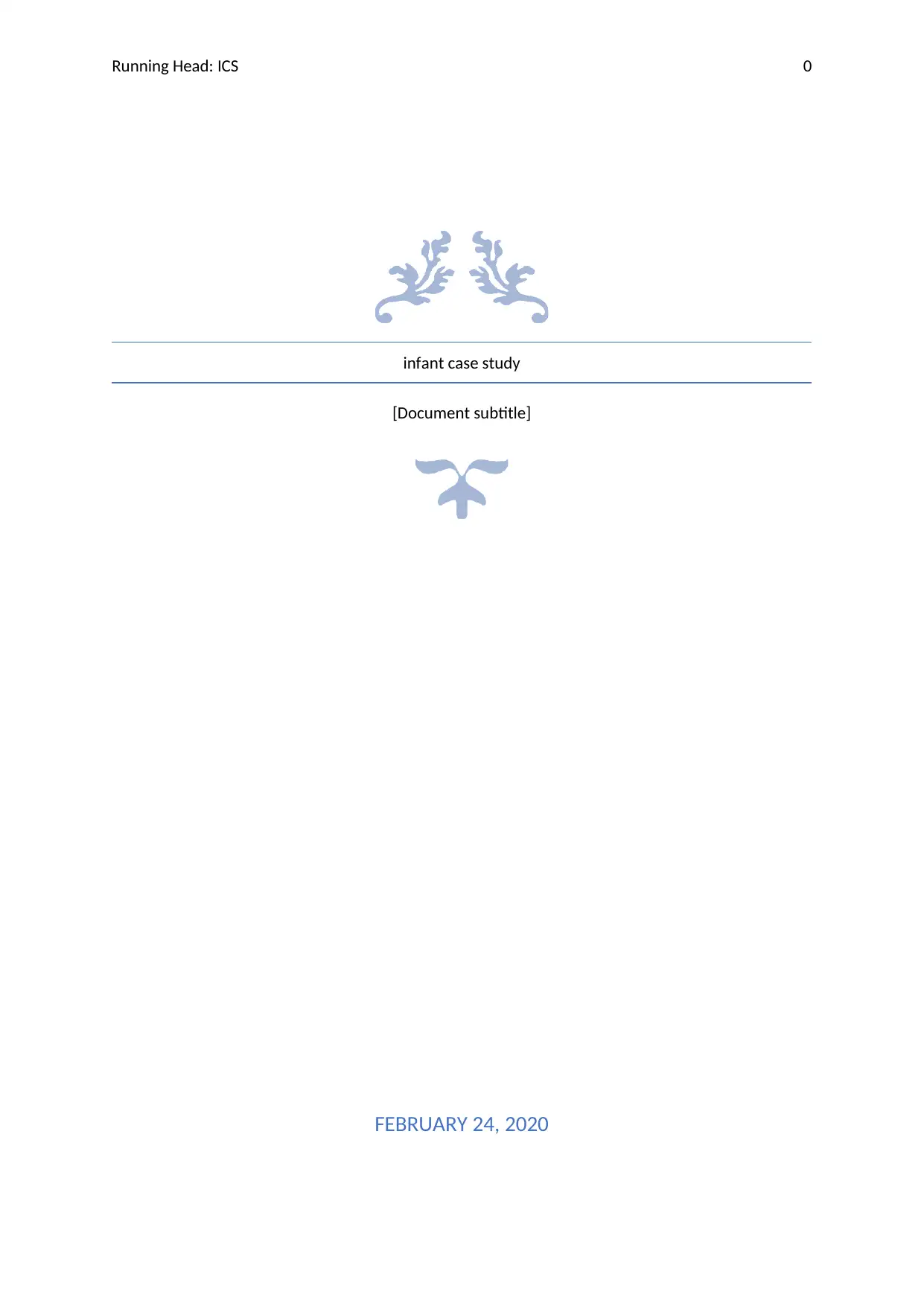
Running Head: ICS 0
infant case study
[Document subtitle]
FEBRUARY 24, 2020
infant case study
[Document subtitle]
FEBRUARY 24, 2020
Paraphrase This Document
Need a fresh take? Get an instant paraphrase of this document with our AI Paraphraser
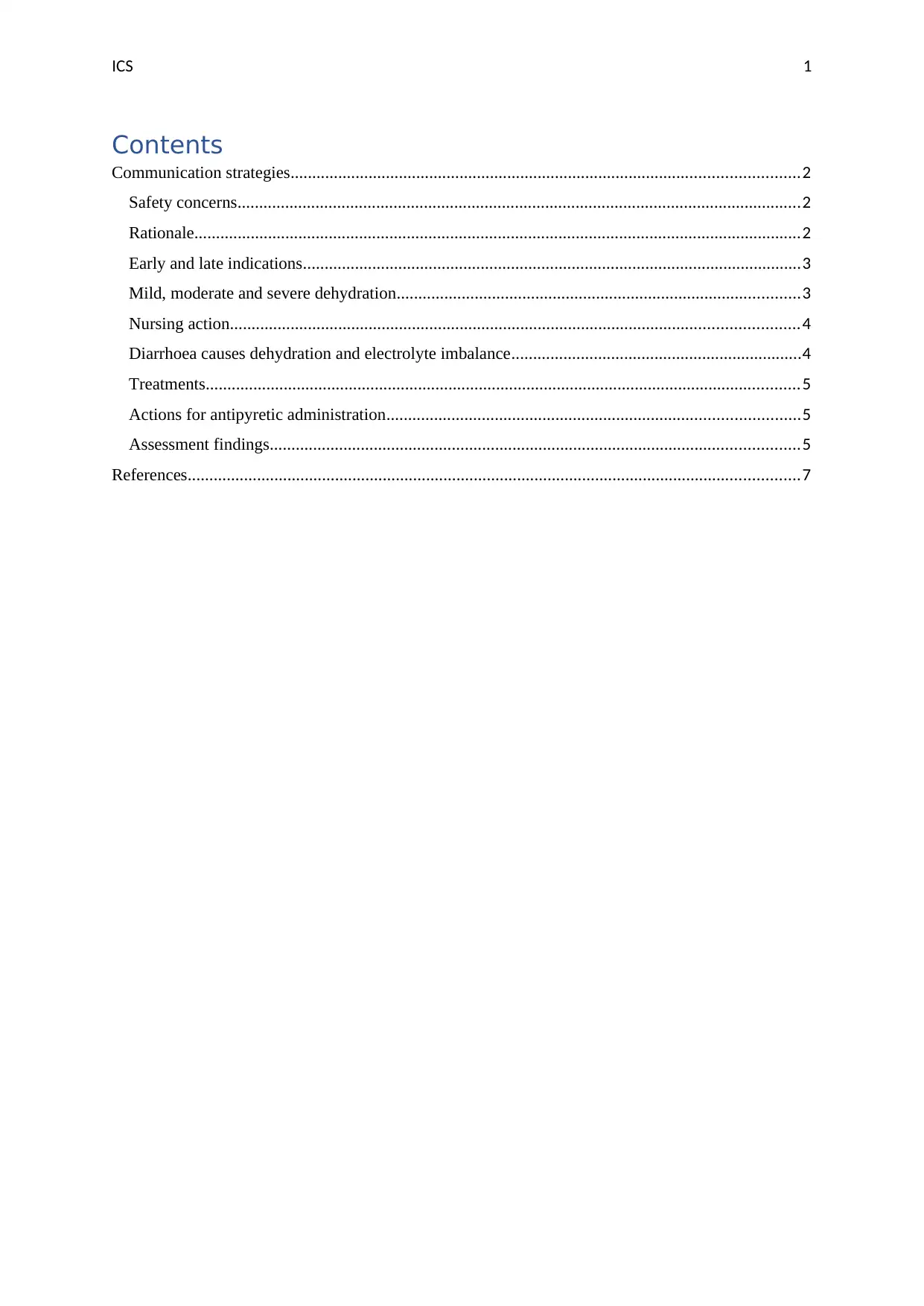
ICS 1
Contents
Communication strategies.....................................................................................................................2
Safety concerns..................................................................................................................................2
Rationale............................................................................................................................................2
Early and late indications...................................................................................................................3
Mild, moderate and severe dehydration.............................................................................................3
Nursing action...................................................................................................................................4
Diarrhoea causes dehydration and electrolyte imbalance...................................................................4
Treatments.........................................................................................................................................5
Actions for antipyretic administration...............................................................................................5
Assessment findings..........................................................................................................................5
References.............................................................................................................................................7
Contents
Communication strategies.....................................................................................................................2
Safety concerns..................................................................................................................................2
Rationale............................................................................................................................................2
Early and late indications...................................................................................................................3
Mild, moderate and severe dehydration.............................................................................................3
Nursing action...................................................................................................................................4
Diarrhoea causes dehydration and electrolyte imbalance...................................................................4
Treatments.........................................................................................................................................5
Actions for antipyretic administration...............................................................................................5
Assessment findings..........................................................................................................................5
References.............................................................................................................................................7
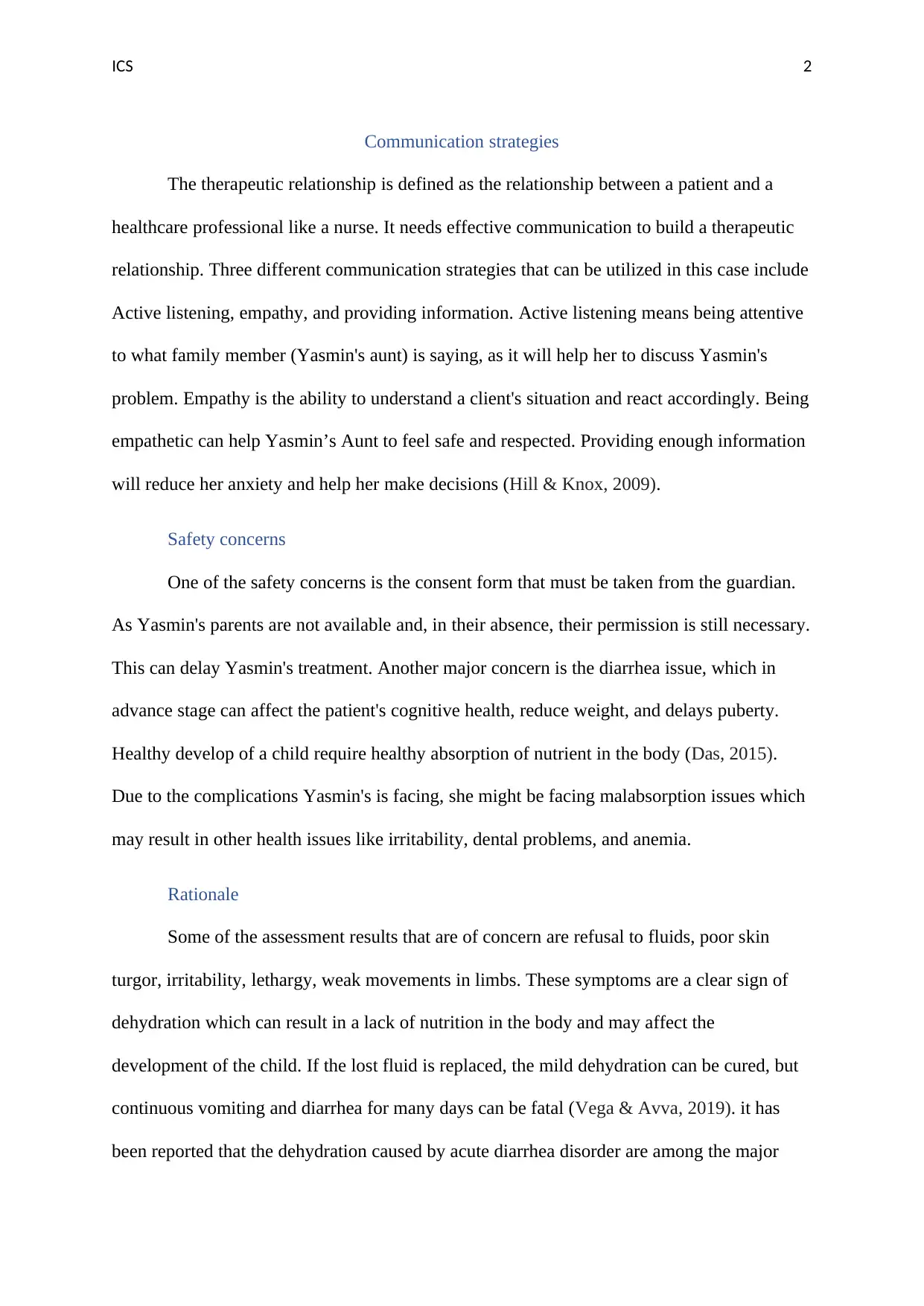
ICS 2
Communication strategies
The therapeutic relationship is defined as the relationship between a patient and a
healthcare professional like a nurse. It needs effective communication to build a therapeutic
relationship. Three different communication strategies that can be utilized in this case include
Active listening, empathy, and providing information. Active listening means being attentive
to what family member (Yasmin's aunt) is saying, as it will help her to discuss Yasmin's
problem. Empathy is the ability to understand a client's situation and react accordingly. Being
empathetic can help Yasmin’s Aunt to feel safe and respected. Providing enough information
will reduce her anxiety and help her make decisions (Hill & Knox, 2009).
Safety concerns
One of the safety concerns is the consent form that must be taken from the guardian.
As Yasmin's parents are not available and, in their absence, their permission is still necessary.
This can delay Yasmin's treatment. Another major concern is the diarrhea issue, which in
advance stage can affect the patient's cognitive health, reduce weight, and delays puberty.
Healthy develop of a child require healthy absorption of nutrient in the body (Das, 2015).
Due to the complications Yasmin's is facing, she might be facing malabsorption issues which
may result in other health issues like irritability, dental problems, and anemia.
Rationale
Some of the assessment results that are of concern are refusal to fluids, poor skin
turgor, irritability, lethargy, weak movements in limbs. These symptoms are a clear sign of
dehydration which can result in a lack of nutrition in the body and may affect the
development of the child. If the lost fluid is replaced, the mild dehydration can be cured, but
continuous vomiting and diarrhea for many days can be fatal (Vega & Avva, 2019). it has
been reported that the dehydration caused by acute diarrhea disorder are among the major
Communication strategies
The therapeutic relationship is defined as the relationship between a patient and a
healthcare professional like a nurse. It needs effective communication to build a therapeutic
relationship. Three different communication strategies that can be utilized in this case include
Active listening, empathy, and providing information. Active listening means being attentive
to what family member (Yasmin's aunt) is saying, as it will help her to discuss Yasmin's
problem. Empathy is the ability to understand a client's situation and react accordingly. Being
empathetic can help Yasmin’s Aunt to feel safe and respected. Providing enough information
will reduce her anxiety and help her make decisions (Hill & Knox, 2009).
Safety concerns
One of the safety concerns is the consent form that must be taken from the guardian.
As Yasmin's parents are not available and, in their absence, their permission is still necessary.
This can delay Yasmin's treatment. Another major concern is the diarrhea issue, which in
advance stage can affect the patient's cognitive health, reduce weight, and delays puberty.
Healthy develop of a child require healthy absorption of nutrient in the body (Das, 2015).
Due to the complications Yasmin's is facing, she might be facing malabsorption issues which
may result in other health issues like irritability, dental problems, and anemia.
Rationale
Some of the assessment results that are of concern are refusal to fluids, poor skin
turgor, irritability, lethargy, weak movements in limbs. These symptoms are a clear sign of
dehydration which can result in a lack of nutrition in the body and may affect the
development of the child. If the lost fluid is replaced, the mild dehydration can be cured, but
continuous vomiting and diarrhea for many days can be fatal (Vega & Avva, 2019). it has
been reported that the dehydration caused by acute diarrhea disorder are among the major
⊘ This is a preview!⊘
Do you want full access?
Subscribe today to unlock all pages.

Trusted by 1+ million students worldwide
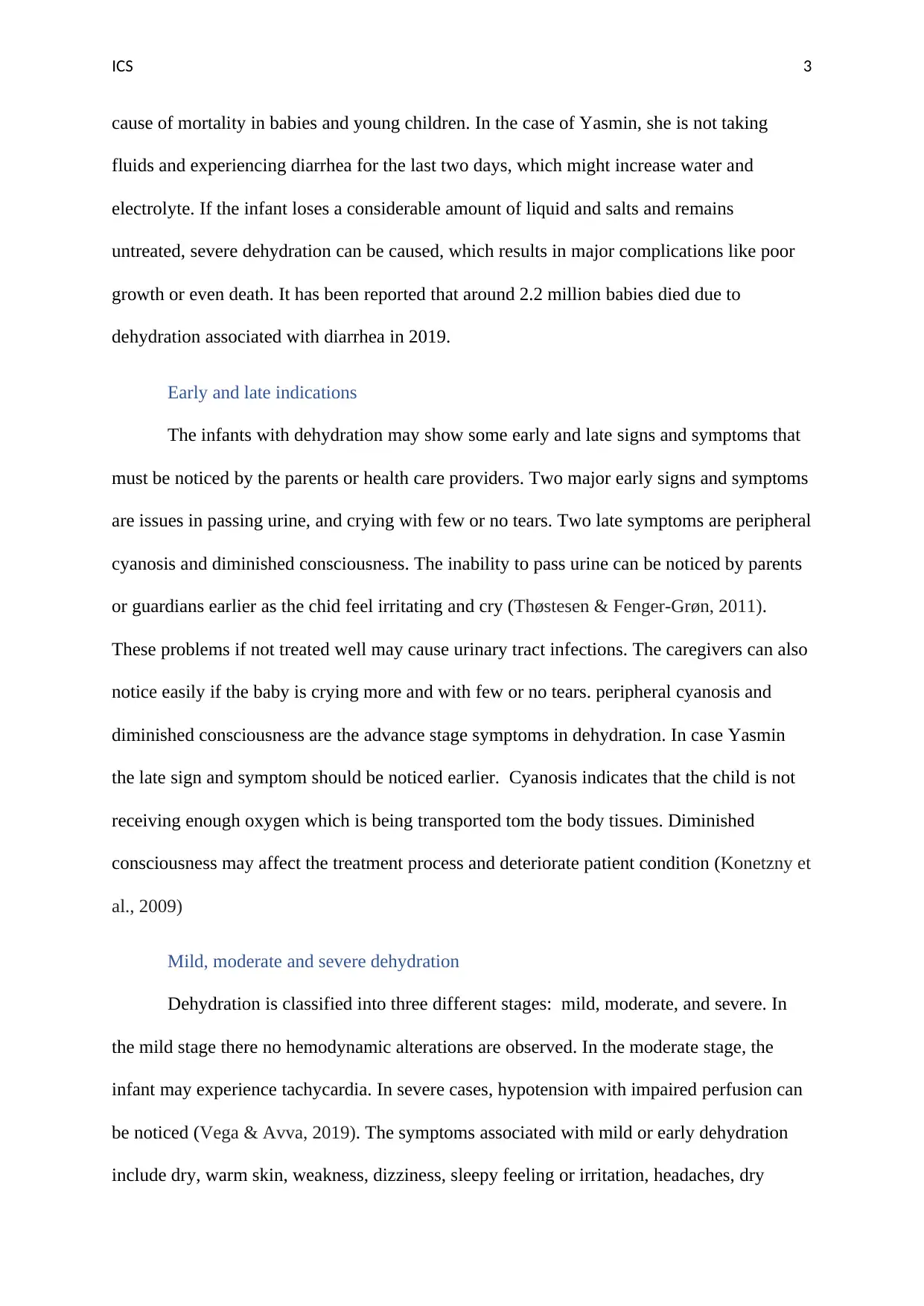
ICS 3
cause of mortality in babies and young children. In the case of Yasmin, she is not taking
fluids and experiencing diarrhea for the last two days, which might increase water and
electrolyte. If the infant loses a considerable amount of liquid and salts and remains
untreated, severe dehydration can be caused, which results in major complications like poor
growth or even death. It has been reported that around 2.2 million babies died due to
dehydration associated with diarrhea in 2019.
Early and late indications
The infants with dehydration may show some early and late signs and symptoms that
must be noticed by the parents or health care providers. Two major early signs and symptoms
are issues in passing urine, and crying with few or no tears. Two late symptoms are peripheral
cyanosis and diminished consciousness. The inability to pass urine can be noticed by parents
or guardians earlier as the chid feel irritating and cry (Thøstesen & Fenger-Grøn, 2011).
These problems if not treated well may cause urinary tract infections. The caregivers can also
notice easily if the baby is crying more and with few or no tears. peripheral cyanosis and
diminished consciousness are the advance stage symptoms in dehydration. In case Yasmin
the late sign and symptom should be noticed earlier. Cyanosis indicates that the child is not
receiving enough oxygen which is being transported tom the body tissues. Diminished
consciousness may affect the treatment process and deteriorate patient condition (Konetzny et
al., 2009)
Mild, moderate and severe dehydration
Dehydration is classified into three different stages: mild, moderate, and severe. In
the mild stage there no hemodynamic alterations are observed. In the moderate stage, the
infant may experience tachycardia. In severe cases, hypotension with impaired perfusion can
be noticed (Vega & Avva, 2019). The symptoms associated with mild or early dehydration
include dry, warm skin, weakness, dizziness, sleepy feeling or irritation, headaches, dry
cause of mortality in babies and young children. In the case of Yasmin, she is not taking
fluids and experiencing diarrhea for the last two days, which might increase water and
electrolyte. If the infant loses a considerable amount of liquid and salts and remains
untreated, severe dehydration can be caused, which results in major complications like poor
growth or even death. It has been reported that around 2.2 million babies died due to
dehydration associated with diarrhea in 2019.
Early and late indications
The infants with dehydration may show some early and late signs and symptoms that
must be noticed by the parents or health care providers. Two major early signs and symptoms
are issues in passing urine, and crying with few or no tears. Two late symptoms are peripheral
cyanosis and diminished consciousness. The inability to pass urine can be noticed by parents
or guardians earlier as the chid feel irritating and cry (Thøstesen & Fenger-Grøn, 2011).
These problems if not treated well may cause urinary tract infections. The caregivers can also
notice easily if the baby is crying more and with few or no tears. peripheral cyanosis and
diminished consciousness are the advance stage symptoms in dehydration. In case Yasmin
the late sign and symptom should be noticed earlier. Cyanosis indicates that the child is not
receiving enough oxygen which is being transported tom the body tissues. Diminished
consciousness may affect the treatment process and deteriorate patient condition (Konetzny et
al., 2009)
Mild, moderate and severe dehydration
Dehydration is classified into three different stages: mild, moderate, and severe. In
the mild stage there no hemodynamic alterations are observed. In the moderate stage, the
infant may experience tachycardia. In severe cases, hypotension with impaired perfusion can
be noticed (Vega & Avva, 2019). The symptoms associated with mild or early dehydration
include dry, warm skin, weakness, dizziness, sleepy feeling or irritation, headaches, dry
Paraphrase This Document
Need a fresh take? Get an instant paraphrase of this document with our AI Paraphraser
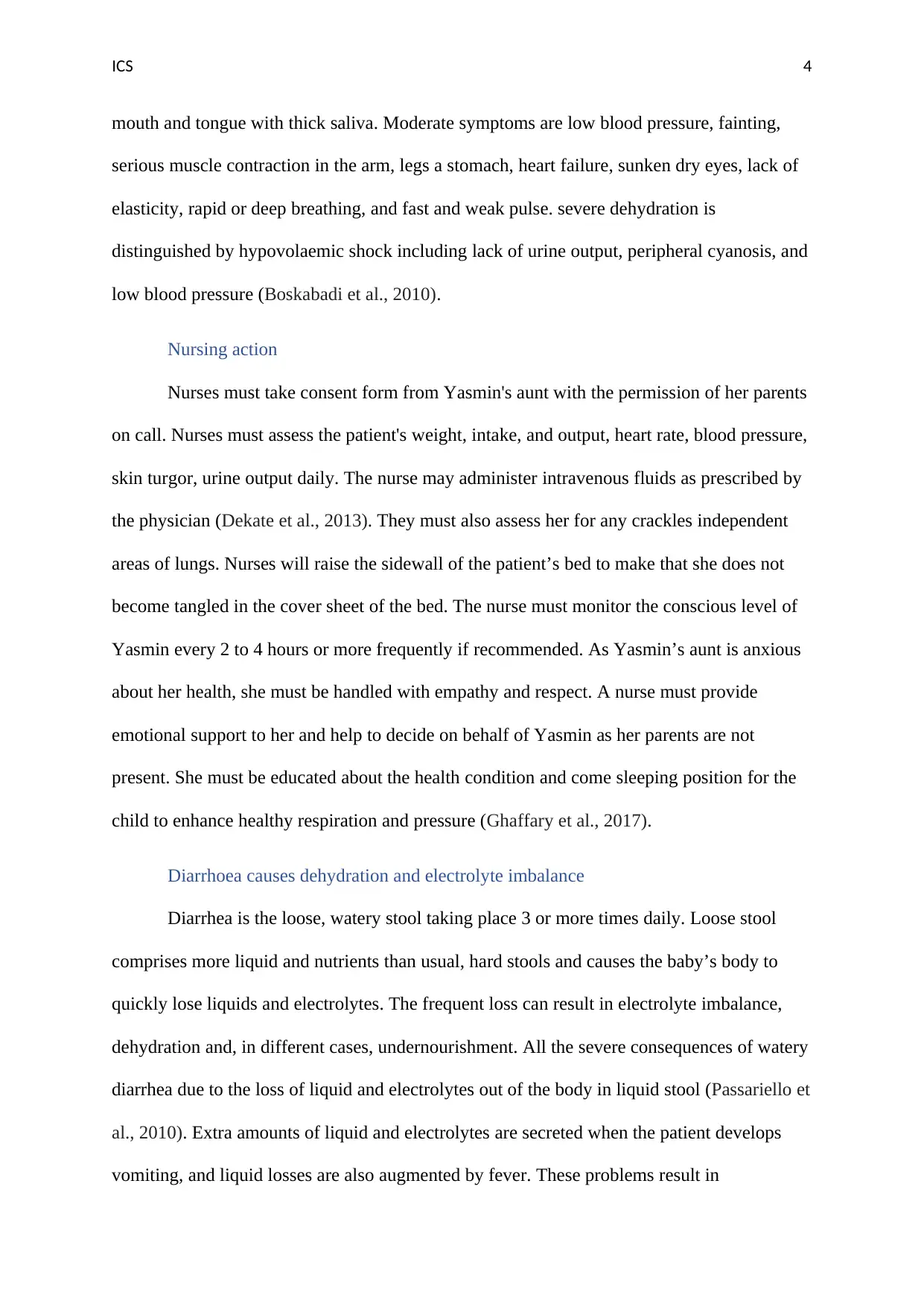
ICS 4
mouth and tongue with thick saliva. Moderate symptoms are low blood pressure, fainting,
serious muscle contraction in the arm, legs a stomach, heart failure, sunken dry eyes, lack of
elasticity, rapid or deep breathing, and fast and weak pulse. severe dehydration is
distinguished by hypovolaemic shock including lack of urine output, peripheral cyanosis, and
low blood pressure (Boskabadi et al., 2010).
Nursing action
Nurses must take consent form from Yasmin's aunt with the permission of her parents
on call. Nurses must assess the patient's weight, intake, and output, heart rate, blood pressure,
skin turgor, urine output daily. The nurse may administer intravenous fluids as prescribed by
the physician (Dekate et al., 2013). They must also assess her for any crackles independent
areas of lungs. Nurses will raise the sidewall of the patient’s bed to make that she does not
become tangled in the cover sheet of the bed. The nurse must monitor the conscious level of
Yasmin every 2 to 4 hours or more frequently if recommended. As Yasmin’s aunt is anxious
about her health, she must be handled with empathy and respect. A nurse must provide
emotional support to her and help to decide on behalf of Yasmin as her parents are not
present. She must be educated about the health condition and come sleeping position for the
child to enhance healthy respiration and pressure (Ghaffary et al., 2017).
Diarrhoea causes dehydration and electrolyte imbalance
Diarrhea is the loose, watery stool taking place 3 or more times daily. Loose stool
comprises more liquid and nutrients than usual, hard stools and causes the baby’s body to
quickly lose liquids and electrolytes. The frequent loss can result in electrolyte imbalance,
dehydration and, in different cases, undernourishment. All the severe consequences of watery
diarrhea due to the loss of liquid and electrolytes out of the body in liquid stool (Passariello et
al., 2010). Extra amounts of liquid and electrolytes are secreted when the patient develops
vomiting, and liquid losses are also augmented by fever. These problems result in
mouth and tongue with thick saliva. Moderate symptoms are low blood pressure, fainting,
serious muscle contraction in the arm, legs a stomach, heart failure, sunken dry eyes, lack of
elasticity, rapid or deep breathing, and fast and weak pulse. severe dehydration is
distinguished by hypovolaemic shock including lack of urine output, peripheral cyanosis, and
low blood pressure (Boskabadi et al., 2010).
Nursing action
Nurses must take consent form from Yasmin's aunt with the permission of her parents
on call. Nurses must assess the patient's weight, intake, and output, heart rate, blood pressure,
skin turgor, urine output daily. The nurse may administer intravenous fluids as prescribed by
the physician (Dekate et al., 2013). They must also assess her for any crackles independent
areas of lungs. Nurses will raise the sidewall of the patient’s bed to make that she does not
become tangled in the cover sheet of the bed. The nurse must monitor the conscious level of
Yasmin every 2 to 4 hours or more frequently if recommended. As Yasmin’s aunt is anxious
about her health, she must be handled with empathy and respect. A nurse must provide
emotional support to her and help to decide on behalf of Yasmin as her parents are not
present. She must be educated about the health condition and come sleeping position for the
child to enhance healthy respiration and pressure (Ghaffary et al., 2017).
Diarrhoea causes dehydration and electrolyte imbalance
Diarrhea is the loose, watery stool taking place 3 or more times daily. Loose stool
comprises more liquid and nutrients than usual, hard stools and causes the baby’s body to
quickly lose liquids and electrolytes. The frequent loss can result in electrolyte imbalance,
dehydration and, in different cases, undernourishment. All the severe consequences of watery
diarrhea due to the loss of liquid and electrolytes out of the body in liquid stool (Passariello et
al., 2010). Extra amounts of liquid and electrolytes are secreted when the patient develops
vomiting, and liquid losses are also augmented by fever. These problems result in
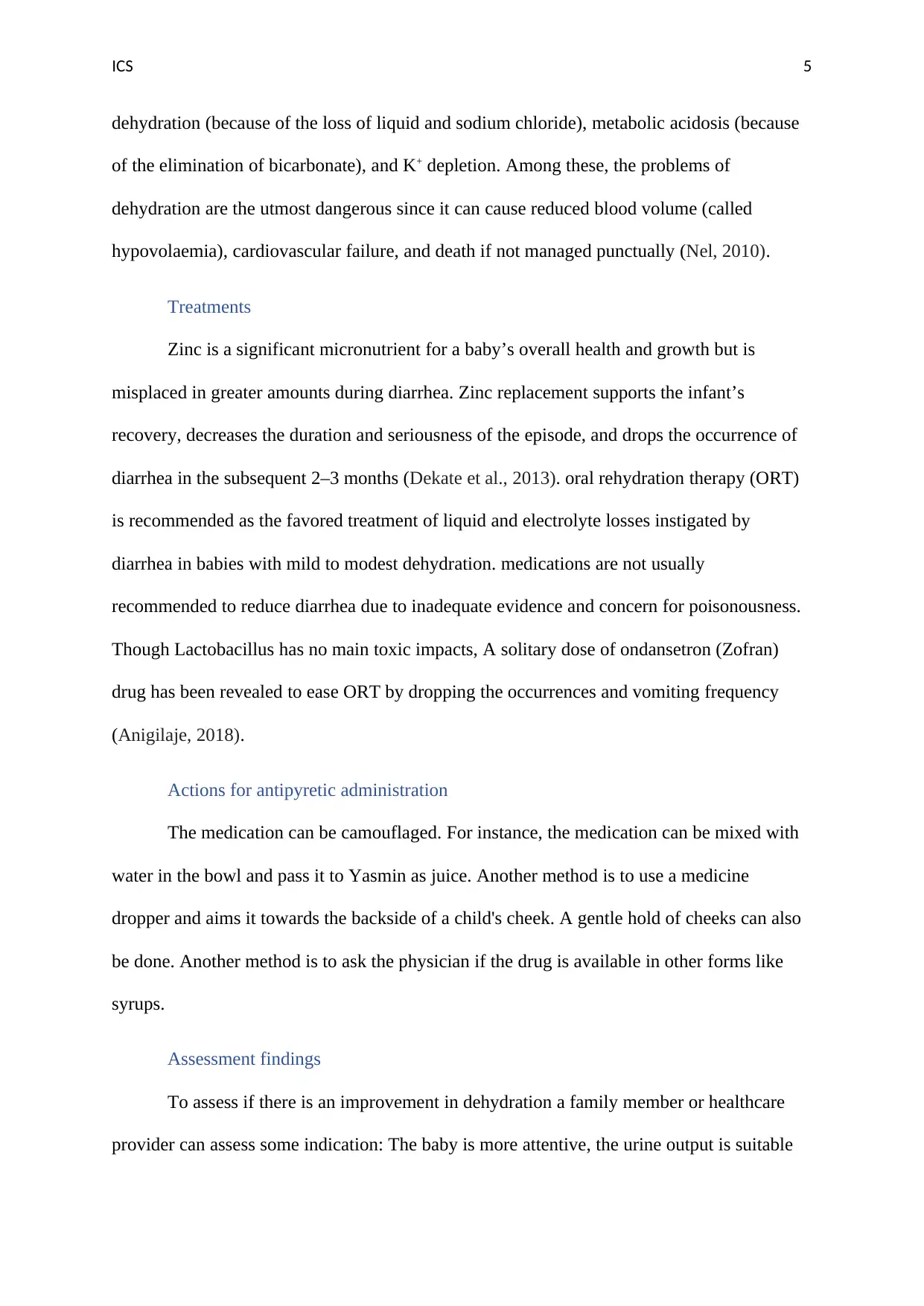
ICS 5
dehydration (because of the loss of liquid and sodium chloride), metabolic acidosis (because
of the elimination of bicarbonate), and K+ depletion. Among these, the problems of
dehydration are the utmost dangerous since it can cause reduced blood volume (called
hypovolaemia), cardiovascular failure, and death if not managed punctually (Nel, 2010).
Treatments
Zinc is a significant micronutrient for a baby’s overall health and growth but is
misplaced in greater amounts during diarrhea. Zinc replacement supports the infant’s
recovery, decreases the duration and seriousness of the episode, and drops the occurrence of
diarrhea in the subsequent 2–3 months (Dekate et al., 2013). oral rehydration therapy (ORT)
is recommended as the favored treatment of liquid and electrolyte losses instigated by
diarrhea in babies with mild to modest dehydration. medications are not usually
recommended to reduce diarrhea due to inadequate evidence and concern for poisonousness.
Though Lactobacillus has no main toxic impacts, A solitary dose of ondansetron (Zofran)
drug has been revealed to ease ORT by dropping the occurrences and vomiting frequency
(Anigilaje, 2018).
Actions for antipyretic administration
The medication can be camouflaged. For instance, the medication can be mixed with
water in the bowl and pass it to Yasmin as juice. Another method is to use a medicine
dropper and aims it towards the backside of a child's cheek. A gentle hold of cheeks can also
be done. Another method is to ask the physician if the drug is available in other forms like
syrups.
Assessment findings
To assess if there is an improvement in dehydration a family member or healthcare
provider can assess some indication: The baby is more attentive, the urine output is suitable
dehydration (because of the loss of liquid and sodium chloride), metabolic acidosis (because
of the elimination of bicarbonate), and K+ depletion. Among these, the problems of
dehydration are the utmost dangerous since it can cause reduced blood volume (called
hypovolaemia), cardiovascular failure, and death if not managed punctually (Nel, 2010).
Treatments
Zinc is a significant micronutrient for a baby’s overall health and growth but is
misplaced in greater amounts during diarrhea. Zinc replacement supports the infant’s
recovery, decreases the duration and seriousness of the episode, and drops the occurrence of
diarrhea in the subsequent 2–3 months (Dekate et al., 2013). oral rehydration therapy (ORT)
is recommended as the favored treatment of liquid and electrolyte losses instigated by
diarrhea in babies with mild to modest dehydration. medications are not usually
recommended to reduce diarrhea due to inadequate evidence and concern for poisonousness.
Though Lactobacillus has no main toxic impacts, A solitary dose of ondansetron (Zofran)
drug has been revealed to ease ORT by dropping the occurrences and vomiting frequency
(Anigilaje, 2018).
Actions for antipyretic administration
The medication can be camouflaged. For instance, the medication can be mixed with
water in the bowl and pass it to Yasmin as juice. Another method is to use a medicine
dropper and aims it towards the backside of a child's cheek. A gentle hold of cheeks can also
be done. Another method is to ask the physician if the drug is available in other forms like
syrups.
Assessment findings
To assess if there is an improvement in dehydration a family member or healthcare
provider can assess some indication: The baby is more attentive, the urine output is suitable
⊘ This is a preview!⊘
Do you want full access?
Subscribe today to unlock all pages.

Trusted by 1+ million students worldwide

ICS 6
for her age with a precise gravity within usual limits, the skin of the infant is more elastic and
soft, the mucous membranes are appeared moist, and the levels of serum pH and electrolyte
are under normal limits.
for her age with a precise gravity within usual limits, the skin of the infant is more elastic and
soft, the mucous membranes are appeared moist, and the levels of serum pH and electrolyte
are under normal limits.
Paraphrase This Document
Need a fresh take? Get an instant paraphrase of this document with our AI Paraphraser
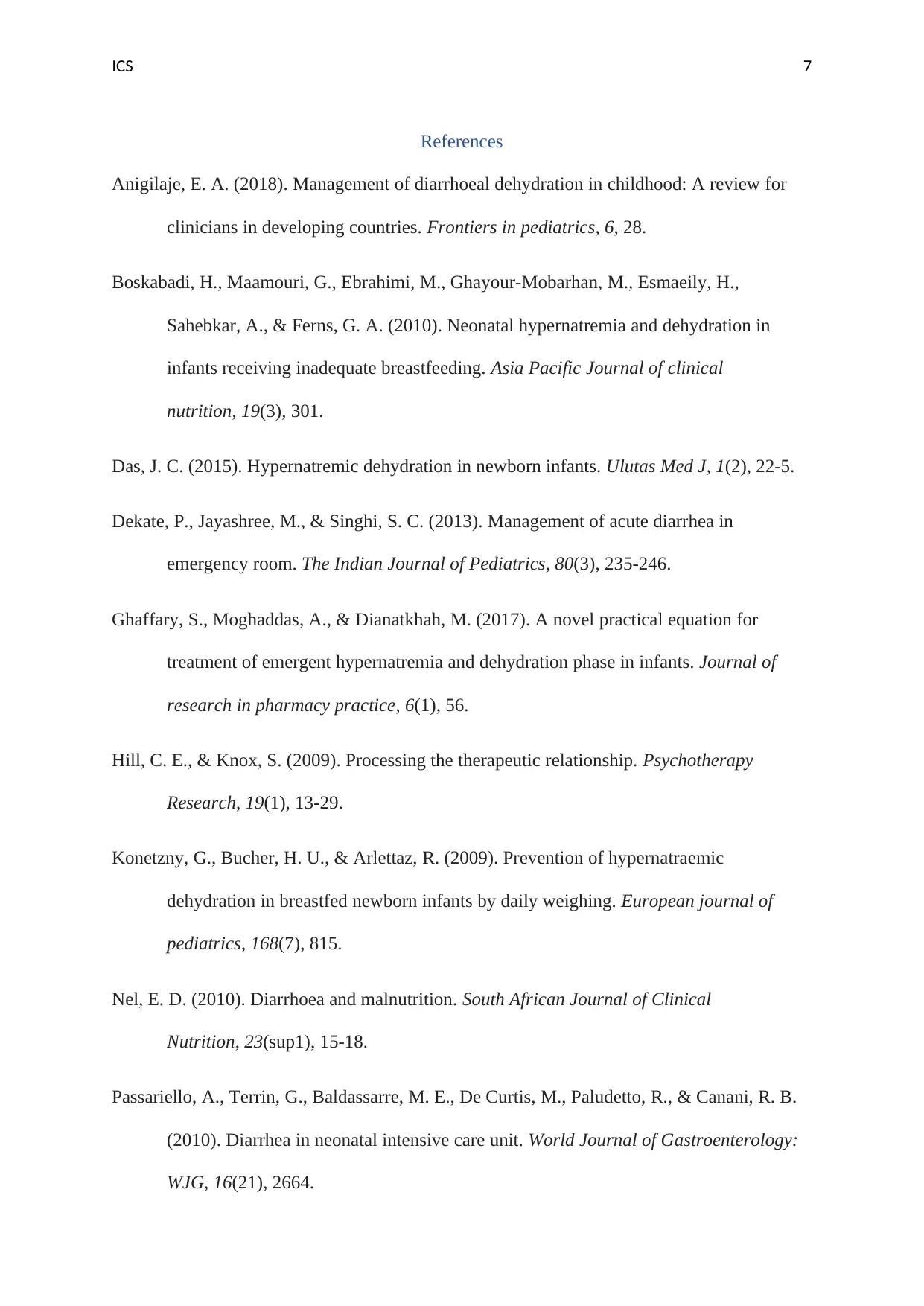
ICS 7
References
Anigilaje, E. A. (2018). Management of diarrhoeal dehydration in childhood: A review for
clinicians in developing countries. Frontiers in pediatrics, 6, 28.
Boskabadi, H., Maamouri, G., Ebrahimi, M., Ghayour-Mobarhan, M., Esmaeily, H.,
Sahebkar, A., & Ferns, G. A. (2010). Neonatal hypernatremia and dehydration in
infants receiving inadequate breastfeeding. Asia Pacific Journal of clinical
nutrition, 19(3), 301.
Das, J. C. (2015). Hypernatremic dehydration in newborn infants. Ulutas Med J, 1(2), 22-5.
Dekate, P., Jayashree, M., & Singhi, S. C. (2013). Management of acute diarrhea in
emergency room. The Indian Journal of Pediatrics, 80(3), 235-246.
Ghaffary, S., Moghaddas, A., & Dianatkhah, M. (2017). A novel practical equation for
treatment of emergent hypernatremia and dehydration phase in infants. Journal of
research in pharmacy practice, 6(1), 56.
Hill, C. E., & Knox, S. (2009). Processing the therapeutic relationship. Psychotherapy
Research, 19(1), 13-29.
Konetzny, G., Bucher, H. U., & Arlettaz, R. (2009). Prevention of hypernatraemic
dehydration in breastfed newborn infants by daily weighing. European journal of
pediatrics, 168(7), 815.
Nel, E. D. (2010). Diarrhoea and malnutrition. South African Journal of Clinical
Nutrition, 23(sup1), 15-18.
Passariello, A., Terrin, G., Baldassarre, M. E., De Curtis, M., Paludetto, R., & Canani, R. B.
(2010). Diarrhea in neonatal intensive care unit. World Journal of Gastroenterology:
WJG, 16(21), 2664.
References
Anigilaje, E. A. (2018). Management of diarrhoeal dehydration in childhood: A review for
clinicians in developing countries. Frontiers in pediatrics, 6, 28.
Boskabadi, H., Maamouri, G., Ebrahimi, M., Ghayour-Mobarhan, M., Esmaeily, H.,
Sahebkar, A., & Ferns, G. A. (2010). Neonatal hypernatremia and dehydration in
infants receiving inadequate breastfeeding. Asia Pacific Journal of clinical
nutrition, 19(3), 301.
Das, J. C. (2015). Hypernatremic dehydration in newborn infants. Ulutas Med J, 1(2), 22-5.
Dekate, P., Jayashree, M., & Singhi, S. C. (2013). Management of acute diarrhea in
emergency room. The Indian Journal of Pediatrics, 80(3), 235-246.
Ghaffary, S., Moghaddas, A., & Dianatkhah, M. (2017). A novel practical equation for
treatment of emergent hypernatremia and dehydration phase in infants. Journal of
research in pharmacy practice, 6(1), 56.
Hill, C. E., & Knox, S. (2009). Processing the therapeutic relationship. Psychotherapy
Research, 19(1), 13-29.
Konetzny, G., Bucher, H. U., & Arlettaz, R. (2009). Prevention of hypernatraemic
dehydration in breastfed newborn infants by daily weighing. European journal of
pediatrics, 168(7), 815.
Nel, E. D. (2010). Diarrhoea and malnutrition. South African Journal of Clinical
Nutrition, 23(sup1), 15-18.
Passariello, A., Terrin, G., Baldassarre, M. E., De Curtis, M., Paludetto, R., & Canani, R. B.
(2010). Diarrhea in neonatal intensive care unit. World Journal of Gastroenterology:
WJG, 16(21), 2664.
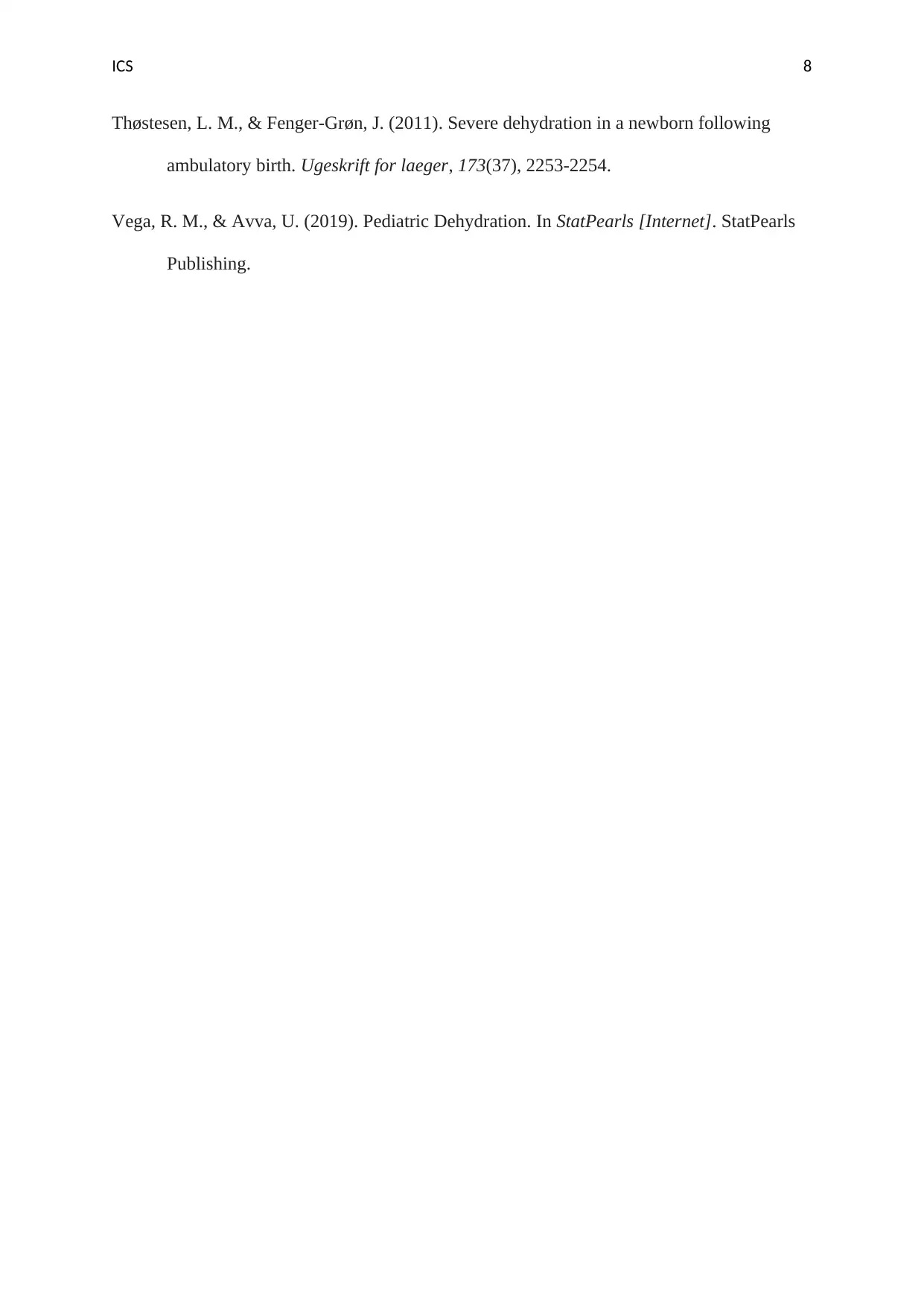
ICS 8
Thøstesen, L. M., & Fenger-Grøn, J. (2011). Severe dehydration in a newborn following
ambulatory birth. Ugeskrift for laeger, 173(37), 2253-2254.
Vega, R. M., & Avva, U. (2019). Pediatric Dehydration. In StatPearls [Internet]. StatPearls
Publishing.
Thøstesen, L. M., & Fenger-Grøn, J. (2011). Severe dehydration in a newborn following
ambulatory birth. Ugeskrift for laeger, 173(37), 2253-2254.
Vega, R. M., & Avva, U. (2019). Pediatric Dehydration. In StatPearls [Internet]. StatPearls
Publishing.
⊘ This is a preview!⊘
Do you want full access?
Subscribe today to unlock all pages.

Trusted by 1+ million students worldwide
1 out of 9
Your All-in-One AI-Powered Toolkit for Academic Success.
+13062052269
info@desklib.com
Available 24*7 on WhatsApp / Email
![[object Object]](/_next/static/media/star-bottom.7253800d.svg)
Unlock your academic potential
Copyright © 2020–2025 A2Z Services. All Rights Reserved. Developed and managed by ZUCOL.

